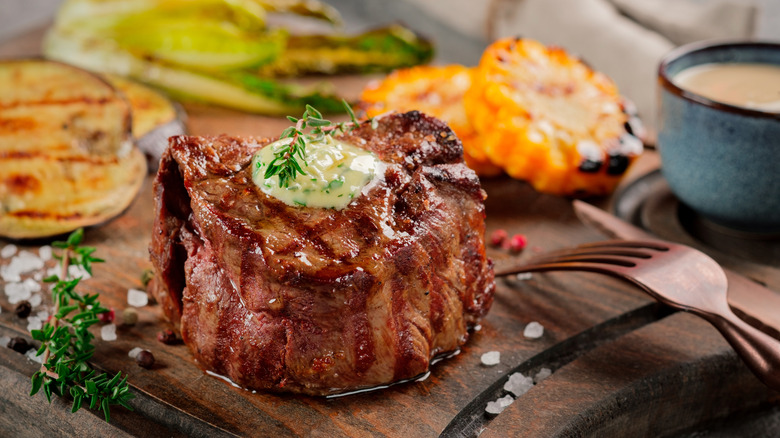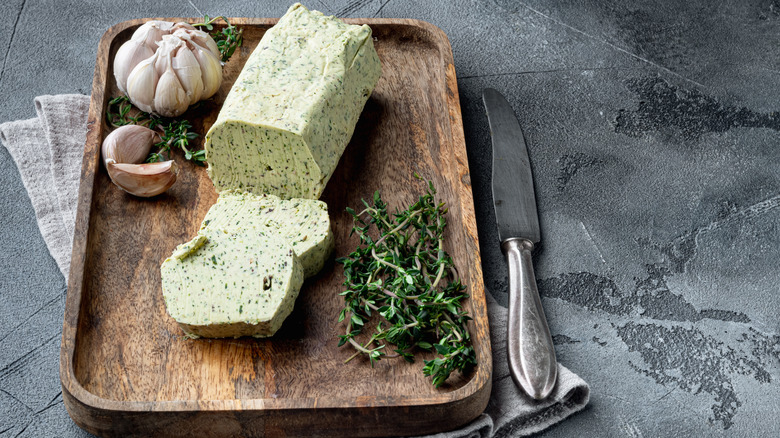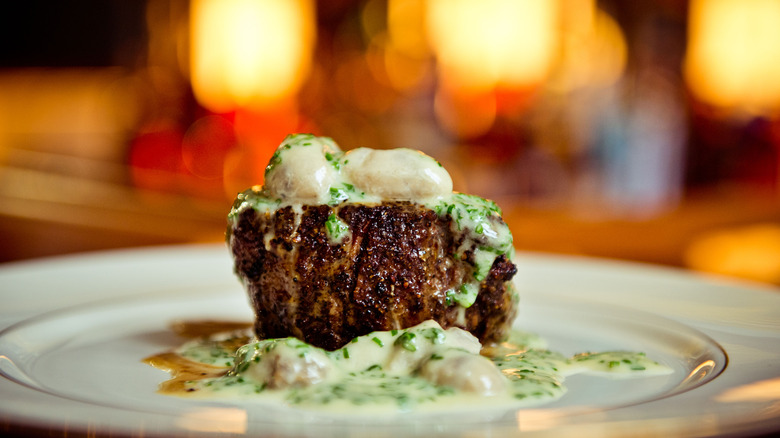Treat Your Steak To A Boozy Compound Butter
Dining at a steakhouse is often a decadent and luxurious treat. There is nothing like a plate of perfectly cooked steak, glistening in melted butter, that makes your mouth water. But as you dig in and savor the taste of the well-marbled meat, have you ever wondered why restaurant steak seems to taste better than the ones you make at home?
There are many ways that a steak's flavor can be improved, and steakhouses are well-versed in them. From dry-aging whole cuts of meat to tenderize them and concentrate their flavor, to sourcing cattle varieties that are unavailable to the average shopper, steakhouses justify their sometimes astronomical prices by distinguishing their products from what you can cook at home.
However, you can improve the flavor of your home-cooked steak by making compound butter. When melted on a just-finished steak, the ingredients mixed into the butter provide a flavor boost alongside the butter's luxurious texture. Moreover, if you add a little bit of alcohol when making compound butter, it can take an already fancy enhancement to another level.
Making boozy compound butters
At its root, a compound butter is a butter with ingredients mixed in it. It is an enhancement used by professional chefs to imbue additional flavor to grilled or pan seared foods.
To make compound butter, you would need softened butter (and there are many different types to choose from), plastic wrap, a mixing bowl and whisk, and whatever you want to add to the butter. No matter what you choose to include in a compound butter, be sure any solids are very finely minced, or else they won't hold well. Also, avoid watery ingredients (like tomato puree) in favor of a drier substitute (such as sun-dried tomatoes). Finally, add alcohol sparingly, as you want the flavor but not the heavy alcohol content, which can make the butter harder to solidify.
For example, let's make a brandy and garlic butter that is a perfect match for steak thanks to the subtle smoky notes of the alcohol. In a bowl, mix softened butter along with finely minced garlic, parsley, and a couple teaspoons of good brandy. Once incorporated, place the semi-solid mixture onto a piece of plastic wrap. Roll the butter inside the wrap until it becomes a log, then twist each end of the wrap until closed, and place it in the fridge to solidify. Alternatively, you can place the mixture in a ramekin and cover it with plastic wrap.
Variations of compound butters
Once you master the method of making compound butter, you can make endless variations of it to fit your cooking needs. For something different to top your steak, try mixing a little vermouth and gin along with very finely minced olives for a martini-flavored compound butter, which pairs perfectly with a dry martini cocktail. For a southwestern flair, mash chipotle peppers and tequila with butter to make a topping for grilled fajitas that go well with margaritas.
Aside from using it on beef, you can even use compound butter to garnish sweet dishes. Try mashing cinnamon, sugar, and rum for a compound butter that is perfect for pancakes. Alternatively, try mixing butter with ground freeze-dried berries and berry-flavored vodka to make butter to melt over a bowl of warm bread pudding. Finally, you can simply use any compound butter on bread as a delicious spread.



